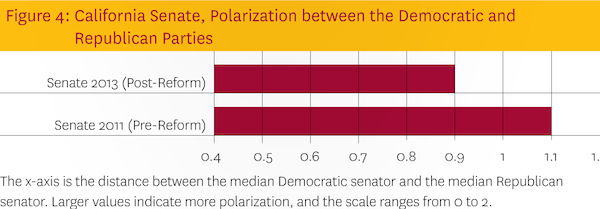California Legislature Less Polarized after Election Reforms, Study Finds

http://www.youtube.com/watch?v=-gcJqHFrhYc#t=145
Since California changed the way it conducts primaries and reshapes its electoral districts, debate over the effects independent redistricting and the nonpartisan top-two primary have had on curbing partisanship in the state has been nonstop. While some opponents of "Top-Two" argue it doesn't, a recent report released by the USC Schwarzenegger Institute says polarization has decreased in the California Legislature since changes to the state's electoral system went into effect.
The study, authored by associate professor of political science at the USC Dornsife College of Letters, Arts, and Sciences, Christian R. Grose, focused on the voting habits of the median legislator in the Assembly and the Senate to measure how partisanship has shifted from the pre-reform 2011 period to 2013. What Grose found was that partisanship in the Legislature has decreased 15 percent in the Assembly and 10 percent in the Senate despite the fact that Democrats have a super-majority.
While proponents and opponents of the top-two primary cite their own studies to back up their position, Grose notes that none of the studies conducted to date have looked at the roll-call choices made by members of the Legislature. Instead, these studies typically focus on policy positions taken during the campaign season.
"This report is the first to examine legislator roll-call voting to assess the extent of ideological moderation after the implementation of the electoral reforms," Grose wrote.
In order to determine the median legislator in both chambers, the 80 members of the Assembly and the 40 members of the Senate were ordered by their left-right ideology. The 41st member of the Assembly and the 21st member of the Senate are considered the "decisive legislator" or the median legislator. The full scale, measured on an x-axis, ranges from -1 (more liberal) to +1 (more conservative).

The median legislator in the Assembly went from -0.74 in 2011 to -0.5 in 2013, showing a more moderate voting pattern.
While Democrats gained seats in the Assembly, Grose found that many of the gains came in districts that elected more moderate candidates. Overall, the analysis finds that both parties moved away from ideological extremes in the Assembly, but most of the reduction in the polarization gap occurred on the Democratic side.The tendency in each party to vote for either a more moderate or more ideology-driven candidate may best be seen in same-party general elections. A new feature in California's election system, and a point of contention for opponents of "Top-Two," general elections can now feature candidates from the same party. This is most likely to happen in electoral districts with lopsided registration numbers that favor one party.
Grose found that in the same-party general elections for Assembly seats, an election between two Democrats had a greater chance of producing a more moderate winner than a Democrat-Republican contest. A Republican-Republican general election, however, did not produce the same results. According to the study, there were not enough same-party general elections in the Senate to analyze.
Still, Grose did find that polarization in the Senate reduced as well, but not as much. This could possibly be explained by the fact that most Republicans in the Senate moved to the right in 2013, compared to GOP voting patterns in 2011. Still, the dramatic shift toward the center among Democrats was enough to reduce the gap between the two parties.
The x-axis used measures the distance between the median Democratic senator and the median Republican senator:

The larger value indicates greater polarization and as the graph indicates, there was a smaller ideological gap between median legislators in the California Senate in 2013 compared to 2011.
This analysis was originally introduced on February 24 during the Schwarzenegger Institute's annual conference on government and leadership. Along with comparing the California Legislature in 2011 with the Legislature in 2013, it also looks at polarization in Congress to see if the reduction in party polarization was a national trend. What is not likely to shock many is that Grose's research shows an increase in party polarization in Congress between 2011 and 2013, and former California Governor Arnold Schwarzenegger believes that California has a model to reverse this trend.In a panel discussion during the conference, Schwarzenegger noted that there are currently 24 states with an initiative process “where we can create changes.” He believes that the redistricting and primary changes made in California could be the solution to counter a level of gridlock where absolutely nothing gets done, which is what people see in Congress today.
In his report, Grose does not go as far as to say conclusively that a reduction in party polarization in California will be a continuous trend, and says that "any conclusion regarding moderation observed in the Legislature in 2013 must be tempered until we see more data across more years of legislatures." He notes in his conclusion, however, that the state is on "the cutting edge" of election and political reform, and it will be interesting to examine further how these reforms affect politics and policy-making in California.
Check out the full report here.
Photo Credit: Mark R / Shutterstock.com





